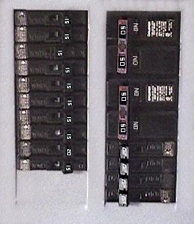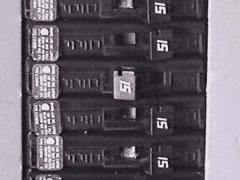 Located inside or outside of your home is a circuit breaker box (sometimes called a fuse box) that contains circuit breakers for each of the circuits in your home. Some homes have more than one circuit breaker box, there may be a main panel plus one or more sub panels in other locations.
Located inside or outside of your home is a circuit breaker box (sometimes called a fuse box) that contains circuit breakers for each of the circuits in your home. Some homes have more than one circuit breaker box, there may be a main panel plus one or more sub panels in other locations.
A circuit breaker provides protection for each of your electrical circuits by stopping the flow of current if an overload or fault occurs. When an electrical fault occurs or the load on your circuit becomes too great, the breaker on that circuit trips and ceases the flow of current to that circuit. A tripped circuit breaker is still sometimes referred to as a “blown fuse” in reference to the older technology that circuit breakers replaced. If your home uses an actual fuse and not a circuit breaker, click here for information on fuse boxes.
Before electricity can be restored, the circuit breaker must be reset. However, even before you do that, you must take steps to ensure that it is safe to do so. Turn off or unplug all of the devices that are plugged into the circuit. Make certain no dangerous condition exists before restoring power.
A circuit breaker which has been tripped will either be in the middle or “OFF” position. Locate the tripped circuit breaker and reset it by pushing it all the way to the “OFF” position and then back to the “ON” position.

Electricity should now be restored to the circuit. If the circuit breaker trips again before you have turned anything on or plugged anything in, a serious wiring fault may exist. Immediately consult a qualified electrician.
If the circuit breaker trips after plugging in or turning on a device, that device may have a short or may be placing too much of a load on the circuit.